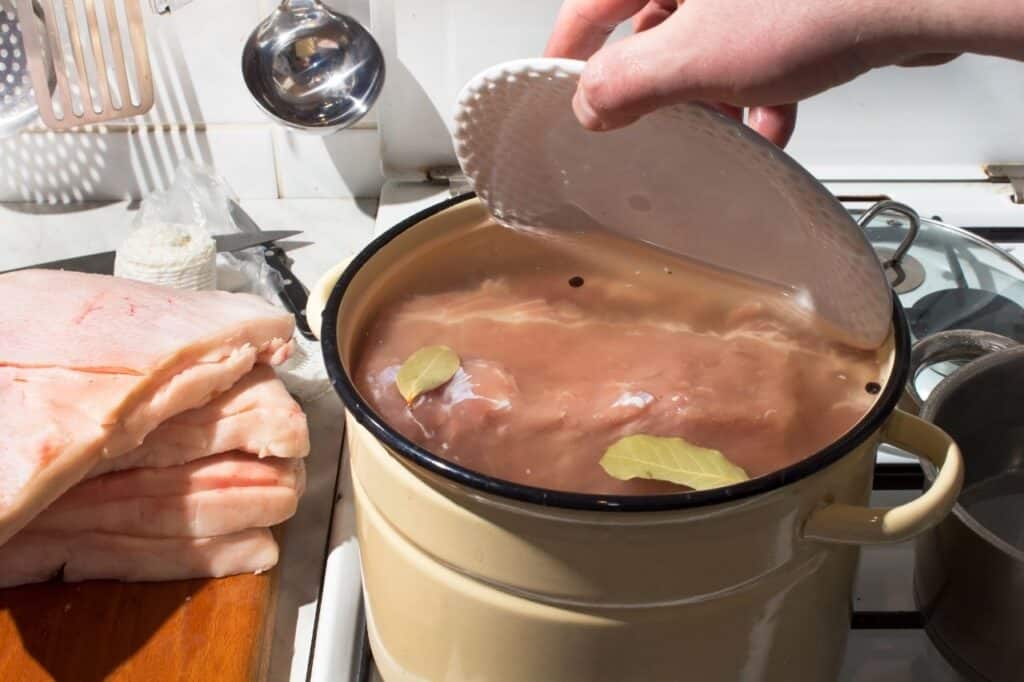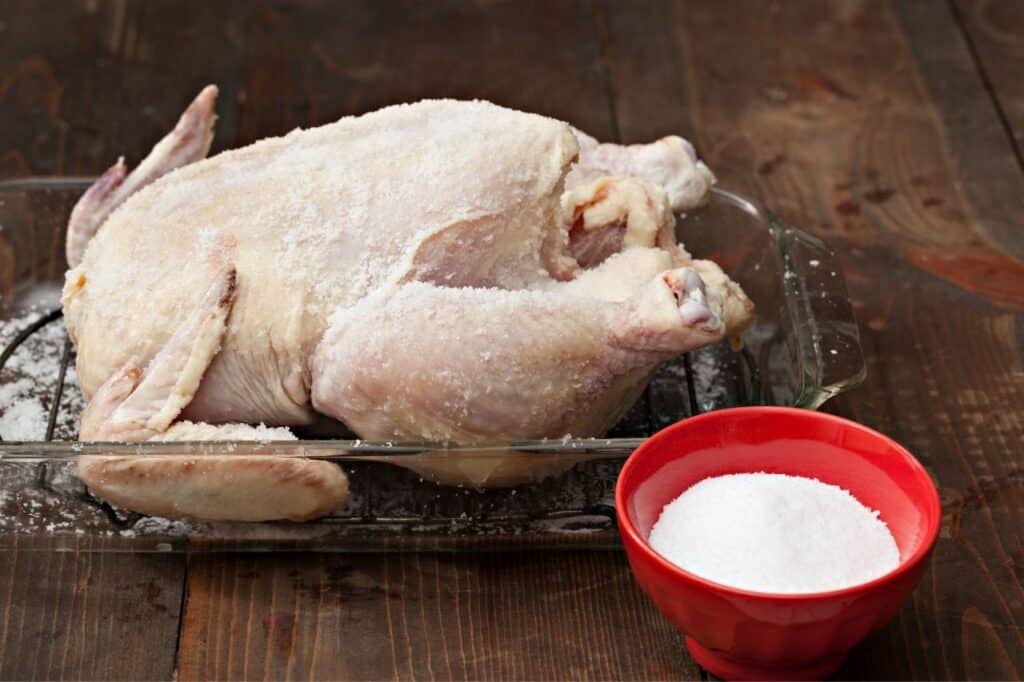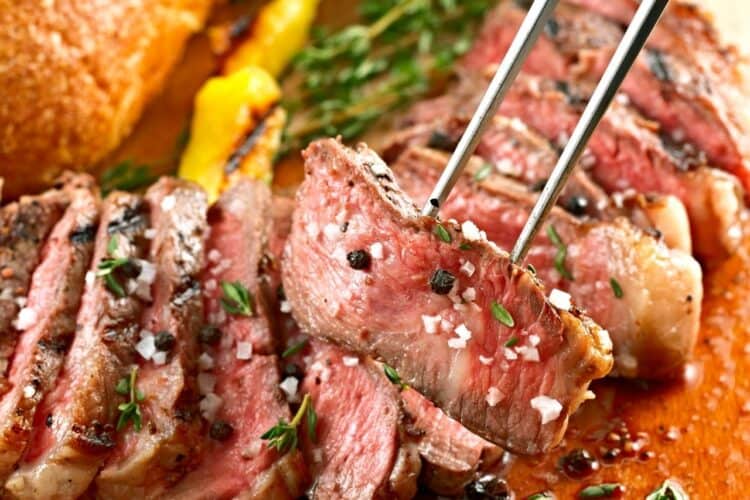There is nothing better than digging in on a flavourful, tender and juicy meat. While there are many ways to achieve this, I find brining the easiest and foolproof way to do it. The only question is, which method of brining to use – dry or wet brining?
Dry brining and wet brining produce almost the same results on most meats. Both methods may work better depending on the type of meat and the cooking process. For instance, wet brining is more suitable for lean meats such as fish, pork loin, and turkey and chicken breasts. Dry brining is recommended if you are using tough meats that require more time for cooking.
While both methods deliver the same results, some people still prefer one method over the other.
How Does Brining Work?
Brining is the process of applying salt to meats to make them more tender and juicier. It can either be through a salt rub or salt solution. There are two types of brining, wet and dry brining. Wet brining, as the name suggests, is made of a salt solution (water and salt). Dry brining on the other hand is simply a salt rub; it does not need water to brine meats.
Brining is done before the meat is cooked. So, is it the same with marinating? No, it is different from marinating since it is not meant to add flavour to the meat. It acts as a buffer to prevent the meat from overcooking, especially on meats that need a longer cooking process. While it does not add flavour, brining helps make meat retain its natural flavour.
Brining works by helping dissolve or break down muscle proteins through salt. These proteins contract as the meat is cooked and squeezes out the meat juices. However, the meat that went through the brining process will not contract or at least helps contract less, thus only a few meat juices were lost. Brining helps minimize moisture lost by at least 30%, making the meat juicier.
What Is Wet Brining?

Wet brining is the process of soaking your meat in saltwater. The main component of wet brine is salt and water. All you have to do is combine salt and water and you’ll have a saltwater or brine solution. The ratio for the salt and water is 1:1, that’s 1 tablespoon of salt to 1 cup of water if you are using table salt. However, if you prefer to use kosher salt, using that ratio will not give you the result you’re looking for.
For kosher salt, you’ll have to use a kitchen scale to get the right measurement. The ratio would be for every 1 gallon of water, you’ll need 10 ounces of kosher salt. Once you have the right amount of salt for the water, set it aside. Salt needs to be dissolved, so you need hot water. When boiling water, be careful not to reach the boiling point as it will make the water evaporate. Turn off the heat when the water is close to boiling.
Mix the salt and the hot water and stir until you’re sure that the salt is completely dissolved. Before you immerse the raw meat, make sure to let the water cool down. You can place the solution in the freezer for a bit to allow it to cool down fast. After that, you can place the meat into the solution. Make sure the meat is fully submerged. Now it can be challenging to keep the meat under so you might need to place something on top of the meat to weigh it down.
Put the container’s lid on and leave it inside the fridge. Once the recommended time of brining is over, remove the meat from the solution and rinse it thoroughly. If you’re brining poultry, make sure to rinse the inside of the meat, too. Failure to rinse wet brined meat may result in overly salty meat. Dry the meat with a paper towel or clean cloth and you’re now ready to cook it. Aside from salt, you can also add other ingredients to your brine solution such as sugar or other seasonings.
What Is Dry Brining?

Dry brining as the name implies is dry and does not require water. However, when it comes to the equipment and process, dry brining is much easier and simpler. All you really need is some salt and a container, but feel free to add other seasonings as well. When it comes to the kind of salt to use, it is better to go for sea salt or kosher salt. Table salt is not recommended for this process since its grain is too fine.
The general rule on the amount of salt to use is at least 1/2 teaspoon of salt for every pound of meat. You can add a little more salt but never less than half a teaspoon. The process is fairly simple – all you need to do is rub salt on your raw meat. You can opt to add other flavourings with your salt rub, just make sure to use only a small amount as you do not want to overpower the salt process.
If you are dry brining large poultry, all you need is at least 1/4 teaspoon for every additional seasoning per pound or half of it for smaller cuts. Some spices you can add are sage, pepper, cayenne, cinnamon, rosemary, and brown sugar.
When dry brining, be sure to thaw the meat first if it’s still frozen. Pat the meat dry using paper towels and massage the meat gently. Get your salt or your dry brine mix and rub it into the meat. When dry brining a whole chicken or turkey, make sure to season both the inside and outside, as well as under the skin.
After ensuring the meat has been thoroughly covered with the dry rub mix, you can place it in a large bag or roasting pan and place it in the fridge. The minimum brining time for a whole turkey or chicken should be about an hour for every pound or at least two to three days. For other meats such as seafood, 15-60 minutes should be enough. For steaks and chops, 12-24 hours and for brisket and prime ribs, dry brine it for 48-72 hours.
Once the brining time is over, you are now ready to cook your meat. No need to rinse, pat dry, or add more seasoning.
Wet Brining Vs. Dry Brining
Now that you know the difference between the two, let’s discuss their pros and cons. This will help you better understand which method is the best for you and your meat.
The Pros and Cons of Brining Method
Wet Brining
Pros
- Helps increase and retain moisture in the meat
- Breaks down muscle proteins
- Suitable for lean and small meat such as chicken and turkey breasts, fish, pork loin
- Requires less brining time
Cons
- Uses more salt than dry brining
- Can take up more space in the fridge
- Requires more equipment and brining process
- Wet brining for too long can result in mushy meat
- May result in diluted meat flavour
- Harder to make the meat’s crust brown and crispy
Dry Brining
Pros
- Helps tenderize meat
- Increase moisture into the meat
- Helps improve meat’s flavour
- Suitable for larger and tougher meats that require a longer cooking process
- The meat won’t end up soggy even after the brining time had passed
- Requires less equipment
- Uses less salt
- Brining process is much easier than wet brining
- Helps make skin-on poultry crispy
- Saves more space
Cons
- Brining time is longer compared to wet brining
- Harder to ensure salt gets into every part of the meat
- It’s harder to ensure salt will penetrate the meat evenly
- Prone to over-salting when the proper salt measurement is not followed
- May cause meat to become dry if dry brining time is not complete
While both schools of brining have their advantages and disadvantages, it’s all up to you which you think will work best with your meat. Aside from the kind of meat, you should also consider the time you need for the brining process and the space inside your fridge. If you are pressed for time, then go for wet brining. If you prefer an easier process that will not take up a lot of space, then dry brining is the way to go.
Related Questions
No, there is no need to rinse meat after dry brining. If you are worried that your meat will be salty, then follow the recommended amount of salt which is 1/2 teaspoon for every pound. Rinsing the dry brined meat will make it harder for your meat to brown and create a crust. Also, for skin-on turkey or chicken, the skin might not be crispy when cooked.
Yes, you can add seasoning into your chicken after brining. However, make sure your dry rub does not contain any salt as the brine is already salty. Aside from dry rubbing your chicken, you can also marinate it with liquid marinades but make sure to use low
- Does Using Pellet Smokers Dry Out Meat? – Myth or Fact - January 4, 2022
- 12 Best Meats To Cook On A Pellet Smoker - December 30, 2021
- Dry Brining: What, How, Why & More - December 28, 2021


